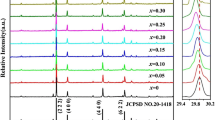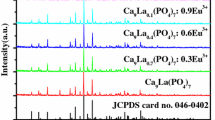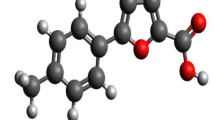Abstract
The development of phosphors for warm white light plays a decisive role in the quest for energy-efficient and environmentally friendly lighting technologies. Lanthanide-based phosphors, especially those containing europium ions (Eu3+), offer promising possibilities as they can emit light in the entire visible spectrum. In this study, the luminescence properties of two Eu3+ complexes, specifically [Eucy1a] and [Eu2cy2], synthesized with macrocyclic ligands are presented. The macrocyclic ligands (cy1a)H3 and (cy2)H6 provide a stable coordination environment that allows fine-tuning of photophysical properties, which are crucial for warm white phosphors. Synthesis, molecular modeling using density functional theory (DFT) and spectroscopic characterization of the complexes were performed. Notably, the complexes showed an inefficient energy transfer from the ligands to the Eu3+ ions, resulting in a broad blue emission spectrum corresponding to the ligand emission and the red 4f–4f transitions of Eu3+,which is important for the generation of white light. Photometric evaluation revealed favorable properties, including correlated color temperatures (CCT) indicative of warm white light, high color rendering index (CRI) values and exceptional Luminous Efficacy of Radiation (LER). In addition, the presence of coordinated water molecules influenced the luminescence lifetime and quantum efficiency of the complexes. Overall, the synthesized Eu3+ complexes show promising prospects for applications in solid-state lighting, LED designs and emergency technologies that offer high performance and energy efficiency.
Graphical Abstract









Similar content being viewed by others
References
Aebischer, A., Gumy, F., Bünzli, J.C.G.: Intrinsic quantum yields and radiative lifetimes of lanthanide tris(dipicolinates). Phys. Chem. Chem. Phys. 11, 1346–1353 (2009). https://doi.org/10.1039/b816131c
Agrawal, D.C., Leff, H.S., Menon, V.J.: Efficiency and efficacy of incandescent lamps. Am. J. Phys. 64, 649–654 (1996). https://doi.org/10.1119/1.18260
Ahn, Y.N., Kim, K. Do, Anoop, G., Kim, G.S., Yoo, J.S.: Design of highly efficient phosphor-converted white light-emitting diodes with color rendering indices (R1−R15) ≥ 95 for artificial lighting. Sci. Rep. 9, 16848 (2019). https://doi.org/10.1038/s41598-019-53269-0
Alstone, P., Jacobson, A.: LED advances accelerate universal access to electric lighting. Comptes Rendus. Phys. 19, 146–158 (2018). https://doi.org/10.1016/j.crhy.2017.10.015
Andreiadis, E.S., Imbert, D., Pécaut, J., Demadrille, R., Mazzanti, M.: Self-assembly of highly luminescent lanthanide complexes promoted by pyridine-tetrazolate ligands. Dalt. Trans. 41, 1268–1277 (2012). https://doi.org/10.1039/c1dt11627d
Annadurai, G., Devakumar, B., Guo, H., Vijayakumar, R., Li, B., Sun, L., Huang, X., Wang, K., Sun, X.W.: Novel Eu3+-activated Ba2Y5B5O17 red-emitting phosphors for white LEDs: high color purity, high quantum efficiency and excellent thermal stability. RSC Adv. 8, 23323–23331 (2018). https://doi.org/10.1039/c8ra03059f
Armelao, L., Quici, S., Barigelletti, F., Accorsi, G., Bottaro, G., Cavazzini, M., Tondello, E.: Design of luminescent lanthanide complexes: from molecules to highly efficient photo-emitting materials. Coord. Chem. Rev. 254, 487–505 (2010). https://doi.org/10.1016/j.ccr.2009.07.025
Bao, G., Wen, S., Lin, G., Yuan, J., Lin, J., Wong, K.-L., Bünzli, J.-C.G., Jin, D.: Learning from lanthanide complexes: the development of dye-lanthanide nanoparticles and their biomedical applications. Coord. Chem. Rev. 429, 213642 (2021). https://doi.org/10.1016/j.ccr.2020.213642
Binder, B.: Color science. Flexo. 33, 38–42 (2008). https://doi.org/10.1016/b0-12-227410-5/00945-5
Binnemans, K.: Interpretation of europium(III) spectra. Coord. Chem. Rev. 295, 1–45 (2015). https://doi.org/10.1016/j.ccr.2015.02.015
Blinova, L.I., Ilichev, V.A., Rumyantsev, R.V., Fukin, G.K., Bochkarev, M.N.: Synthesis, structure, and luminescent properties of lanthanide complexes containing 1,10-phenanthroline and perfluorinated 2-mercaptobenzothiazolate ligands. Russ. Chem. Bull. 67, 1261–1267 (2018). https://doi.org/10.1007/s11172-018-2210-8
Bünzli, J.C.G.: On the design of highly luminescent lanthanide complexes. Coord. Chem. Rev. 293–294, 19–47 (2015). https://doi.org/10.1016/j.ccr.2014.10.013
Chang, C.A.: Lanthanide macrocyclic complexes: structure, thermodynamics, kinetics, and applications, pp. 169–299 (2017). https://doi.org/10.1016/bs.hpcre.2017.05.001
De Bettencourt-Dias, A.: Introduction to lanthanide ion luminescence. Lumin. Lanthan. Ions Coord. Compd. Nanomater. 9781119950, 1–48 (2014). https://doi.org/10.1002/9781118682760.ch01
Dolg, M., Cao, X.: Relativistic pseudopotentials: their development and scope of applications. Chem. Rev. 112, 403–480 (2012). https://doi.org/10.1021/cr2001383
Dolg, M., Stoll, H., Savin, A., Preuss, H.: Energy-adjusted pseudopotentials for the rare earth elements. Theor. Chim. Acta. 75, 173–194 (1989). https://doi.org/10.1007/BF00528565
Dong, L., Zhang, L., Jia, Y., Shao, B., Lü, W., Zhao, S., You, H.: Synthesis, luminescence and application of novel europium, cerium and terbium-doped apatite phosphors. CrystEngComm 21, 6226–6237 (2019). https://doi.org/10.1039/C9CE01105F
Erdem, T., Demir, H.V.: Color science of nanocrystal quantum dots for lighting and displays. Nanophotonics. 2, 57–81 (2013). https://doi.org/10.1515/nanoph-2012-0031
Falcony, C., Balderas, J.U.: On the use of organic ligands to sensitize inorganic phosphors for ultraviolet, visible, and infrared light harvesting. J. Vac. Sci. Technol. B 37, 028501 (2019). https://doi.org/10.1116/1.5084283
Fan, F., Zhao, L., Shang, Y., Liu, J., Chen, W., Li, Y.: Thermally stable double-perovskite Ca3TeO6: Eu 3+ red-emitting phosphors with high color purity. J. Lumin. 211, 14–19 (2019). https://doi.org/10.1016/j.jlumin.2019.03.001
Frisch, M. J.; Trucks, G. W.; Schlegel, H. B.; Scuseria, G. E.; Robb, M.A.. C., J. R.; Scalmani, G.; Barone, V.; Petersson, G. A.; Nakatsuji, H.: Gaussian 09 (2009)
Hagemann, H., Bill, H., Rey, J.M., Kubel, F., Calame, L., Lovy, D.: Europium-doped Ba 7 F 12 Cl 2, a single component near-UV excited tunable white phosphor. J. Phys. Chem. C 119, 141–147 (2015). https://doi.org/10.1021/jp510301p
Hasegawa, M., Ohmagari, H., Tanaka, H., Machida, K.: Luminescence of lanthanide complexes: from fundamental to prospective approaches related to water- and molecular-stimuli. J. Photochem. Photobiol. C Photochem. Rev. 50, 100484 (2022). https://doi.org/10.1016/j.jphotochemrev.2022.100484
Hou, Y.-F., Dral, P.O.: Kernel method potentials. In: Quantum Chemistry in the Age of Machine Learning. pp. 295–312. Elsevier, Amsterdam (2023)
Kang, J., Chen, Y.N., Wang, A.L., Li, H.Y., Qu, Y.R., Zhang, H.X., Chu, H. Bin, Zhao, Y.L.: Synthesis, characterization and luminescent properties of europium complexes with 2,4,6-tris-(2-pyridyl)-s-triazine as highly efficient sensitizers. Luminescence. 30, 1360–1366 (2015). https://doi.org/10.1002/bio.2906
Kariaka, N.S., Smola, S.S., Rusakova, N.V., Dyakonenko, V.V., Shishkina, S.V., Sliva, T.Y., Trush, V.A., Amirkhanov, V.M.: Synthesis, crystal structure and luminescent properties of novel lanthanide complexes with CAPh type ligand diphenyl-N-benzoylamidophosphate and bidentate nitrogen donors. J. Lumin. 223, 117187 (2020). https://doi.org/10.1016/j.jlumin.2020.117187
Li, P., Wang, Z., Yang, Z., Guo, Q.: A novel, warm, white light-emitting phosphor Ca2PO4 Cl: Eu2+, Mn2+ for white LEDs. J. Mater. Chem. c. 2, 7823–7829 (2014). https://doi.org/10.1039/C4TC01055H
Li, X., Budai, J.D., Liu, F., Howe, J.Y., Zhang, J., Wang, X.-J., Gu, Z., Sun, C., Meltzer, R.S., Pan, Z.: New yellow Ba0.93Eu0.07Al2O4 phosphor for warm-white light-emitting diodes through single-emitting-center conversion. Light Sci. Appl. 2, e50–e50 (2013). https://doi.org/10.1038/lsa.2013.6
Li, G., Xia, M., Liu, J., Zheng, J., Zhao, B., Peng, H.: Deep blue fluorescent emitters based imidazole and carbazole for non-doped organic light emitting diodes with CIEy≤0.05. Dye. Pigment. 213, 111183 (2023). https://doi.org/10.1016/j.dyepig.2023.111183
Liu, R.-S., Wang, X.-J.: Phosphor Handbook. CRC Press, Boca Raton (2021)
Lopez-Ruiz, L.E., Salas-Juárez, C.J., Garduño-Wilches, I., Beltran, H.I., Orozco-Valencia, U., López-Esquivel, R.I., Guzman-Olguin, J.C., Centeno-Alvarez, M., Guzman-Mendoza, J.: Luminescent analysis of [Eu2DPA3] MOF as high purity red-emitting phosphor with thermal stability. J. Lumin. 263, 120020 (2023). https://doi.org/10.1016/j.jlumin.2023.120020
McCamy, C.S.: Correlated color temperature as an explicit function of chromaticity coordinates. Color. Res. Appl. 17, 142–144 (1992). https://doi.org/10.1002/col.5080170211
Moerman, F.: Hygienic design concepts for lighting in the food industry. In: Hygienic Design of Food Factories. pp. 531–623. Elsevier, AMsterdam (2023)
Moret, E., Bünzli, J.C.G., Schenk, K.J.: Structural and luminescence study of europium and terbium nitrate hexahydrates. Inorganica Chim. Acta. 178, 83–88 (1990). https://doi.org/10.1016/S0020-1693(00)88138-4
Nair, G.B., Swart, H.C., Dhoble, S.J.: A review on the advancements in phosphor-converted light emitting diodes (pc-LEDs): phosphor synthesis, device fabrication and characterization. Prog. Mater. Sci. 109, 100622 (2020). https://doi.org/10.1016/j.pmatsci.2019.100622
Navarro, R.E., Coronado, A., Inoue, M., Orozco Valencia, Á.U., Soberanes, Y., Salazar-Medina, A.J.: Gd(III) and Yb(III) complexes derived from a new water-soluble dioxopolyazacyclohexane macrocycle. ACS Omega 8, 34575–34582 (2023). https://doi.org/10.1021/acsomega.3c03454
Navarro, R.E., Soberanes, Y., D-Yañez, S., Jatomea, O., Ramírez, J.Z., Inoue, M.: Isomeric DTPA-amide macrocycles of p-xylenediamine and their complexation with Gd3+. Polyhedron. 92, 105–110 (2015). https://doi.org/10.1016/j.poly.2015.03.011
Omary, M.A., Patterson, H.H.: Luminescence, Theory. In: Encyclopedia of Spectroscopy and Spectrometry. pp. 636–653. Elsevier, Amsterdam (2017)
Otsuka, T., Oka, R., Hayakawa, T.: Eu 3+ Site distribution and local distortion of photoluminescent Ca 3 WO 6: (Eu 3+, K +) double perovskites as high‐color‐purity red phosphors. Adv. Sci. 10, (2023). https://doi.org/10.1002/advs.202302559
Pode, R.: Organic light emitting diode devices: an energy efficient solid state lighting for applications. Renew. Sustain. Energy Rev. 133, 110043 (2020). https://doi.org/10.1016/j.rser.2020.110043
Qiao, J., Zhao, J., Liu, Q., Xia, Z.: Recent advances in solid-state LED phosphors with thermally stable luminescence. J. Rare Earths 37, 565–572 (2019). https://doi.org/10.1016/j.jre.2018.11.001
Roy, I., David, A.H.G., Das, P.J., Pe, D.J., Stoddart, J.F.: Fluorescent cyclophanes and their applications. Chem. Soc. Rev. 51, 5557–5605 (2022). https://doi.org/10.1039/D0CS00352B
Ruivo, A., Laia, C.: CIE color coordinates for the design of luminescent glass materials. Color. Res. Appl. 49, 199–214 (2024). https://doi.org/10.1002/col.22907
Salas-Juárez, C.J., Navarro, R.E., Pérez-Rodríguez, A., Orozco-Valencia, U., Aceves, R.: Visual temperature sensor and luminescent thermometer based on the complex Tb/Eu–TPTZ incorporated in transparent PMMA film. Sensors Actuators A Phys. 315, 112293 (2020). https://doi.org/10.1016/j.sna.2020.112293
Sato, M., Kim, S.W., Shimomura, Y., Hasegawa, T., Toda, K., Adachi, G.: Rare earth-doped phosphors for white light-emitting diodes. pp. 1–128 (2016). https://doi.org/10.1016/bs.hpcre.2016.03.001
Sijbom, H.F., Verstraete, R., Joos, J.J., Poelman, D., Smet, P.F.: K_2SiF_6:Mn^4+ as a red phosphor for displays and warm-white LEDs: a review of properties and perspectives. Opt. Mater. Express 7, 3332 (2017). https://doi.org/10.1364/OME.7.003332
Soberanes, Y., Navarro, R.E., Inoue, M., Santacruz-Ortega, H., Pérez-González, R., Ochoa Lara, K., Sotelo-Mundo, R.R.: Interaction of Na+ and K+ ions with DTPA-amide dioxa-pentaaza-cyclophanes: effect of electrostatic field in macrocyclic cavity on UV absorption spectra and protonation. J. Incl. Phenom. Macrocycl. Chem. 92, 419–426 (2018). https://doi.org/10.1007/s10847-018-0864-3
Supkowski, R.M., Horrocks, W.D.: On the determination of the number of water molecules , q , coordinated to europium (III) ions in solution from luminescence decay lifetimes. Inorganica Chim. Acta 340, 44–48 (2002)
Tang, Q., Liu, S., Liu, Y., He, D., Miao, J., Wang, X., Ji, Y., Zheng, Z.: Color tuning and white light emission via in situ doping of luminescent lanthanide metal-organic frameworks. Inorg. Chem. 53, 289–293 (2014). https://doi.org/10.1021/ic402228g
van Bommel, W.: Tubular and compact fluorescent lamp. In: Encyclopedia of Color Science and Technology. pp. 1548–1559. Springer International Publishing, Cham (2023)
Wang, Z., Lou, S., Li, P.: Single phase tunable warm white-light-emitting Sr_3La(PO_4)_3:Eu^2+, Sm^3+ phosphor for white LEDs. Opt. Mater. Express 6, 114 (2016). https://doi.org/10.1364/OME.6.000114
Wu, M., Zhuang, Y., Liu, J., Chen, W., Li, X., Xie, R.J.: Ratiometric fluorescence detection of 2,6-pyridine dicarboxylic acid with a dual-emitting lanthanide metal-organic framework (MOF). Opt. Mater. (Amst). 106, 110006 (2020). https://doi.org/10.1016/j.optmat.2020.110006
Xu, J., Chen, G.: Realizing white LEDs with high luminous efficiency and high color rendering index by using double green phosphors. Results Phys. 15, 102648 (2019). https://doi.org/10.1016/j.rinp.2019.102648
Xu, Q., Li, Z., Wang, Y., Li, H.: Temperature-dependent luminescence properties of lanthanide(III) β-diketonate complex-doped LAPONITE®. Photochem. Photobiol. Sci. 15, 405–411 (2016). https://doi.org/10.1039/c5pp00413f
Yang, D., Li, Z., He, L., Deng, Y., Wang, Y.: Solvent free mechanochemical synthesis of Eu3+ complex and its luminescent sensing of trace water and temperature. RSC Adv. 7, 14314–14320 (2017). https://doi.org/10.1039/c6ra28099d
Zheng, X., Liu, Y., Pan, M., Lü, X., Zhang, J., Zhao, C., Tong, Y., Su, C.: Bright blue-emitting Ce 3+ complexes with encapsulating polybenzimidazole tripodal ligands as potential electroluminescent devices. Angew. Chemie Int. Ed. 46, 7399–7403 (2007). https://doi.org/10.1002/anie.200702401
Zhu, P., Zhu, H., Adhikari, G.C., Thapa, S.: Spectral optimization of white light from hybrid metal halide perovskites. OSA Contin. 2, 1880 (2019). https://doi.org/10.1364/OSAC.2.001880
Zissis, G., Bertoldi, P., Serrenho, T.: Update on the Status of LED-Lighting world market since 2018, EUR 30500 EN Publications Office of the European Union Luxembourg, 2021, ISBN 978-92-76-27244-1, https://doi.org/10.2760/759859, JRC122760 (2018)
Acknowledgements
Ch. J. Salas-Juarez acknowledges support from CONAHCYT through Postdoctoral project No. 2638495. Alex J. Salazar-Medina thanks CONAHCYT for the program “Investigadoras e Investigadores por México”. The authors also thank to the Supramolecular Chemistry Thematic Network and the University of Sonora for providing computational resources through the ACARUS-UNISON supercomputer for this work. Additionally, the Polymers and Materials Research Department (DIPM) of the University of Sonora is acknowledged for the support through Project No. USO316009041.
Funding
Mexico National Council of Humanities Science and Technology (CONAHCYT): Project No. CF-2023-I-2251.
Author information
Authors and Affiliations
Contributions
All authors contributed to the research conception and design. A.S.M.: Methodology, Investigation, Conceptualization, Formal analysis, Writing - Original Draft. R.E.N.: Conceptualization, Methodology, Formal analysis, Resources, Supervision, Project administration. H.S.O.: Methodology, Conceptualization, Investigation. A.U.O.V.: Software, Methodology, Formal analysis. R.L.E.: Methodology, Conceptualization, Investigation. YS. : Conceptualization, Methodology, Formal analysis, Resources, Supervision, Project administration. C.J.S.J.: Methodology, Conceptualization, Investigation, Data Curation, Formal analysis, Writing - Original Draft, , Writing - Review & Editing
Corresponding authors
Ethics declarations
Conflict of interest
The authors declared no potential conflicts of interest with respect to the research, authorship and publication of this article.
Additional information
Publisher's Note
Springer Nature remains neutral with regard to jurisdictional claims in published maps and institutional affiliations.
Supplementary Information
Below is the link to the electronic supplementary material.
Rights and permissions
Springer Nature or its licensor (e.g. a society or other partner) holds exclusive rights to this article under a publishing agreement with the author(s) or other rightsholder(s); author self-archiving of the accepted manuscript version of this article is solely governed by the terms of such publishing agreement and applicable law.
About this article
Cite this article
Salazar-Medina, A.J., Navarro, R.E., Santacruz-Ortega, H. et al. Luminescence properties of Eu3+ complexes based on macrocyclic ligands and its colorimetric analysis for white warm phosphor. Opt Quant Electron 56, 1064 (2024). https://doi.org/10.1007/s11082-024-07013-2
Received:
Accepted:
Published:
DOI: https://doi.org/10.1007/s11082-024-07013-2




